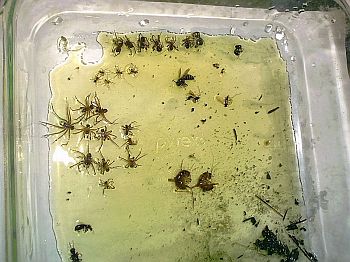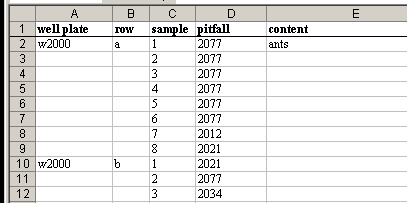
All photos on this page are by Bruce G. Marcot
This page illustrates the process of sorting terrestrial invertebrates into groups of morphospecies, as the first step in identification of specimens.
Click on each image for larger versions.
After the initial capture of invertebrates in the field, we first dump the specimens from each sample into a lasagna pan with a small amount of ethylene glycol, and begin the sorting process using fine-tipped tweezers and dissecting needles. In a few minutes, we are able to separate the initial groups, such as shown here:
This image shows 4 spider groups (don't overlook the two tiny spider dots in the upper left corner), at least 2 ant groups, 2 fly groups, 3 beetle groups, 1 cricket group, and a lot of dross (in the lower right corner).
Here is another sample:
This pan has 1 millipede, 4 spider groups, and 3 beetle groups.
Each morphospecies group goes into a different, labeled well plate. For example:
or spiders:
Each well plate is uniquely numbered. Further, within the well plates, each row is lettered (A, B, C, ...) and each column is numbered (1, 2, 3,...). I keep a spreadsheet that lists the unique field sample number that goes into each well of each plate. Here's an example:

Then, the next steps entail further separating the organisms into other numbered well plates, for species identification. At that stage, the number of individual organisms in each well also are counted as part of the data set. In this way, with ancillary data on weight (wet weight, dry weight, or kcal/g energy content), I can convert captures into (a) presence of each species, (b) frequency (nos. of individuals), (c) biomass, and (d) standing crop energy (kcal).
But that's for later. At the initial sorting stage, just scanning the variety and numbers of individuals by body sizes across the wells within each plate is a quick visual cue to the body size diversity present in the samples. For example, here is one well plate in which spider morphospecies have been sorted:
This is a quick and very crude measure, of course, because the variation that appears in each well plate depends on how many individuals occupy each well, but you can see that pretty clearly too.
Well plates come in at least a couple of sizes for tiny and moderately-sized invertebrates. For the larger specimens, such as these Scaphinotus beetles, I use petri dishes:
The number of well plates can add up as more morphospecies groups are defined.
The well plate names I used for initial sorting (within which further, individual morphospecies groups are included) are:
| ants | |
| larger spiders | |
| micryphantid (micro) spiders | |
| mites | |
| springtails | |
| orthopterans | |
| arachnids | |
| beetles | |
| tiny beetle-like | |
| flies & allies (mostly dipterans) | |
| diploda & chilopoda (centipedes and millipedes) | |
| aphids | |
| very tiny winged ants or flies | |
| wasps and bees | |
| mollusks | |
| lepidoptera (moths, butterflies) | |
| hemiptera & "friends" (tiny buggy things -- like true bugs) | |
| misc. and unknown |
And finally here's the lab setup. We use the large magnifying lens/light combination to do the sorting.
